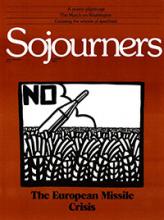It started out as a simple closing song for one of the nightly general meetings: "You can't kill the spirit, she's like a mountain, old and strong, she goes on and on." About 50 women stood in a spiral, circle wrapped around circle, singing and swaying beneath a wooden pavilion lined with banners and workshop schedules.
Near the circle's center the pace of the verse quickened. The women, smiling, began to clap and dance to the song's ever more rhythmic beat. Then they joined hands, and the circles began to move around each other in a flowing connected motion. As the song slowed, the women stopped and moved together toward the center, arm in arm, until they were in a tight huddle.
The song became softer and softer, beautiful high voices echoing each line. And then it fell to a low hum. And then silence. Tears welled, and the women stood immersed in a spirit of strength and unity—clutching one another, holding one another up, creating a nucleus of hope for their futures, for the world's future.
These women were standing, acting, and celebrating on land bordering the Seneca Army Depot. The depot occupies 11,000 acres of land encircled with miles of chain-link fence and barbed wire. A center of nuclear storage and research since 1944, it now stores the neutron bomb and is the most likely point from which first-strike weapons will be shipped for deployment in Europe. The depot is then, for many, a place that symbolizes the thwarting of hope for the future. But now a new hope has taken root on the depot's very borders: the Women's Encampment for a Future of Peace and Justice.
Read the Full Article

